Artifacts and ecofacts
Saint-Louis Forts and Châteaux National Historic Site
Pierre Cloutier and Jacques Guimont – Archaeologists
To date, the digs have generated a large quantity of artifacts and ecofacts associated with all periods of the site's occupation, from Champlain to the time the château burned.
Objects from the French regime (1620-1759)
Champlain's era
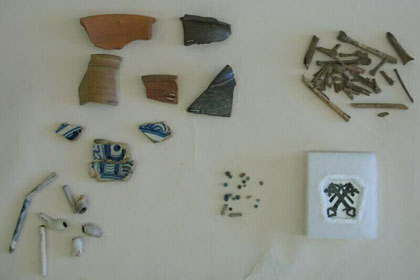 Champlain's era: Normandy stoneware and French terracotta, leftover bones from birds, majolica from the Netherlands, Dutch or English pipes, beads for the fur trade trade and a papal insignia.
Champlain's era: Normandy stoneware and French terracotta, leftover bones from birds, majolica from the Netherlands, Dutch or English pipes, beads for the fur trade trade and a papal insignia.
This is the first time that artifacts from Champlain have been found in upper Quebec! Among them are fragments of Normandy and Beauvais stoneware and majolica from the Netherlands , as well as rassade beads from the fur trade. Several Dutch or English pipe bowls are also among the items discovered.
Papal insignia
Among the objects from the first half of the 17th century was a small insignia carved in a thin sheet of copper having the form of two crossed keys with opposite bits, a symbol of the papal coat of arms. Only representatives of the pope could have worn the insignia in the colony: the Jesuit missionaries who arrived in Quebec in 1626.
Amerindian objects
Amerindian objects such as green fragments of chert, a fragment of a stone tool, and two black pipes were mixed with the artifacts from this period. Glass or rassade beads lost by Amerindians have also been found as well as several European white clay pipes smoked by Amerindians inside the fort.
Rich soil
Many artifacts from the French regime were found in the soil in the south yard, such as those placed for the construction of the 1691 cannon platforms and those left after the battery of cannons was abandoned in 1742.
17 th century soil
Soil accumulated before 1691 contained:
- A large quantity of rassades (glass beads)
- A lead seal undoubtedly associated with the site's first years of occupation
- A few coins from under Henry IV and Louis XIV (two douzains from 1594 and 1595, a quarter ecu from 1603, a farthing from 1656)
 A douzain from 1594.
A douzain from 1594.
- Small dice made of bone
- Many remains of bones, which are invaluable in documenting part of the governor's menu from the 17th century.
18 th century soil
Soil deposited after 1742 contained:
- Many fragments of wine bottles, which included the blazon of Charles de La Boische, marquis de Beauharnois, governor between 1726 and 1747.
- The same blazon was painted in the centre of several faience plates.
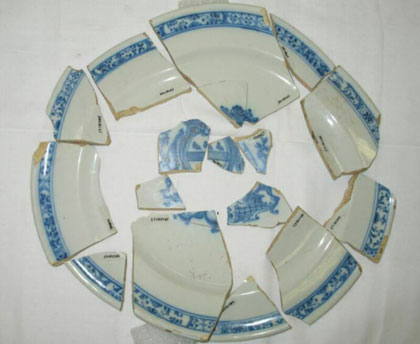 Fragments of an unrestored faience plate decorated with the coat of arms of governor Beauharnois
Fragments of an unrestored faience plate decorated with the coat of arms of governor Beauharnois
- A significant quantity of bone remains (butcher products, small fur and winged game, and a large variety of fish), which helps determine the diet of French governors shortly before the Conquest.
Luxury items
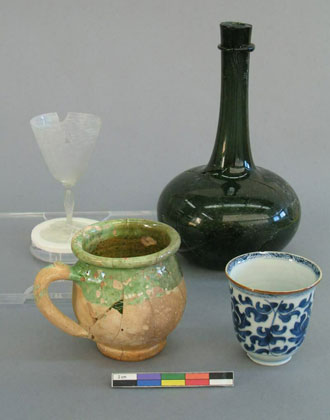 Vaudreuil's era: wine glasses made with verre de fougère, a wine bottle, a varnished earthenware cauldron, a china goblet for coffee or chocolate
Vaudreuil's era: wine glasses made with verre de fougère, a wine bottle, a varnished earthenware cauldron, a china goblet for coffee or chocolate
Although few in number, several excavated objects from the French regime bear witness to a certain degree of luxury. Among them were the following, found in a latrine pit which was abandoned in 1719:
- A bottle from a model made in France between 1660 and 1700
- Venetian-style wine glasses made with verre fougère and clear glass
- A goblet made of Chinese porcelain
- An earthenware cauldron common to the Bordeaux region.
Many artillery projectiles
The 1759 bombardment left relatively little mark on the overall site, which was clearly tidied of most of the artillery projectiles launched from the south shore of the Saint Lawrence River. Some of the projectiles were recuperated and used to build the foundation of a building, whose remains were excavated during digs in 2001 near the Frontenac kiosk, to the north of the site. It was the largest collection of projectiles associated with the bombardment of Quebec gathered together in one location. Forty-five different projectiles were identified. Among them:
- Various calibre cannon balls
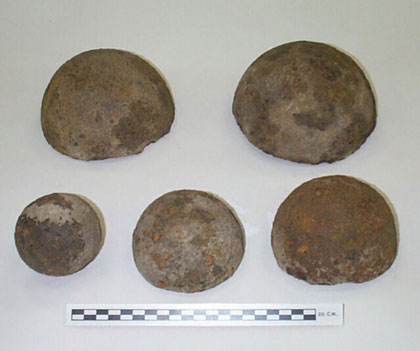 Cannon balls launched during the siege of Quebec in 1759
Cannon balls launched during the siege of Quebec in 1759
- Bombs
- Shells
- Hand grenades.
Objects from the English regime (1763-1834)
Valuable latrines
Artifacts from the daily lives of British governors came largely from two latrine pits abandoned in 1817, when water toilets were installed in the château.
Dishes
The first latrine pit included:
- More than 20 Wedgwood brand creamware plates – a popular brand in the last two decades of the 18th century – thrown out possibly because they were no longer in style or no longer pleased a new governor
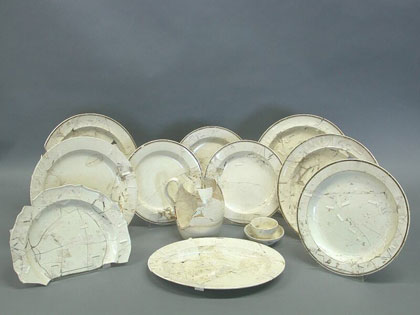 Unrestored creamware objects found in a latrine pit, which was filled in around 1817
Unrestored creamware objects found in a latrine pit, which was filled in around 1817
- An impressive collection of lead table glassware :
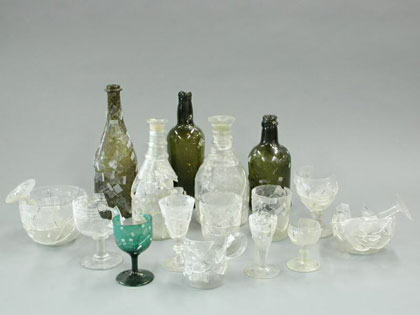 Part of the unrestored glassware found in the latrine pit, which was filled in around 1817
Part of the unrestored glassware found in the latrine pit, which was filled in around 1817
- More than a hundred wine glasses of various sizes
- Several carafes
- Several ice-pails
Body-care objects
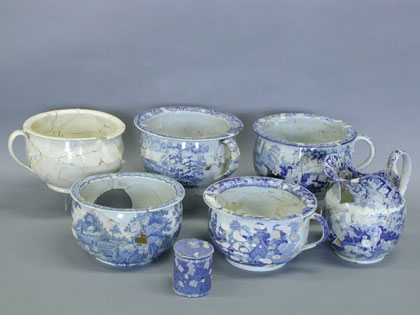 Five chamber pots, a water jug, and an ointment jar left in the latrine pit, which was used from 1811 to 1817
Five chamber pots, a water jug, and an ointment jar left in the latrine pit, which was used from 1811 to 1817
Items associated more with personal care and hygiene were found in the second latrine pit:
- Chamber pots
- Oitment jars
- Bottles for perfumed lotions
- Uwers
- Toilet basins
- Pins for adjusting clothing
- A gold pin set with turquoises imported from China and used to hold a hat or turban.
In the southern yard
Among other objects worth mentioning for this period and found in the southern yard were larding needles (to insert pieces of fat into meat) and a cast-iron stove plate decorated with an image of a crown of feathers.
A revealing garbage pit
A garbage pit full of bone remains, located just below the window off the wash house in the southern part of the château, revealed a wide variety of domestic and wild mammal bones, an impressive variety of fish remains, and the usually rare shells from shellfish.
Bone analysis would provide invaluable information about British fare at the governor's table at the turn of the 19th century.- Date modified :